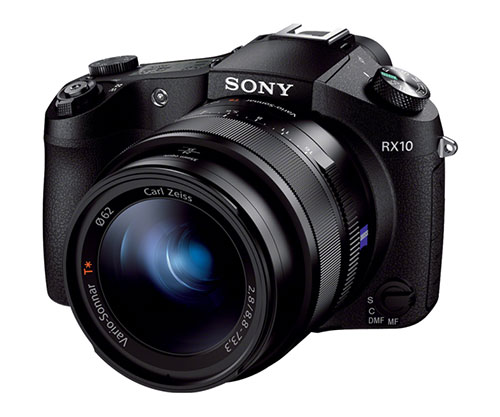
The Basics
The Sony DSC-RX10 is not exactly what it appears to be.What’s that– you say? Well, it’s a 20 Megapixel 1″ Exmore-R sensor equipped body with a permanent 8.8–73.3mm (24–200mm f/2.8 equivalent) Zeiss Vario Sonnar lens. It has a high resolution tiltable rear LCD and a high resolution high eye-point EVF. There is a top panel LCD, and dual mode image stabilization (including optical). And for those doing discrete shooting, the shutter is almost completely silent.
The RX10 shoots raw and JPG stills at up to 10 FPS. In video mode it is a so-called “World Camera” as it can shoot both NTSC (North America and Japan) and PAL…rest of the world. It shoots AVCHD 2.0 at up to 28 Mbps, and at both 24/25P and 50/60P. Full manual control is available when shooting video. In a unique feature for a camera of this type there is a built in Neutral Density filter. This is handy for still photographers wanting to use wide apertures and slow shutter speeds in bright sunlight, but more importantly obviates the need for external variable ND filters when shooting video outdoors.
And, speaking of video, this is where the RX10 may be more than it appears to be. The traditional aperture ring (hooray) can be set to have tactile and audible third-stop click-stops, or to be continuous and silent in operation. There is focus peaking and zebras, a mic input with user settable levels, and a headphone jack. There is “clean” uncompressed HDMI video output for feeding an external video recorder.
Finally, and still summarizing major video features, the camera’s 20MP sensor (5K in video speak) is sub-sampled to HD resolution for video, instead of using line skipping. Almost every other hybrid stills / video camera thus far (and that now includes virtually every camera made in the past few years) uses line skipping to get their larger sensor down to the sub-2K needed for HD video. The RX10 is the first camera to sample the sensors raw output in real time at up to 60 frames per second and then record HD video. The advantage of this is potentially reduced moire, and possibly visibly higher resolution with less artifacting of all sorts.
In brief, the RX10 is a sort of “Bridge Camera”, as they are called. Usually these have small sensors and long focal ranges. The RX10 trades off the superzoom aspect for a shorter focal range but a fixed f/2.8 maximum aperture and also a larger sensor than other Bridge camera models.
Some History First

In 2005 Sony introduced theDCS-R1, a camera which had many photographers scratching their heads in puzzlement while others were rubbing their hands in glee.You can read my contemporaneous review here. A lot has happened in the photographic industry in the 8 years since, but the new RX10 (available December, 2013) is the inheritor of the R1’s DNA and much of its design ethos.
While the R1 had a 10MP almost APS-C sized sensor, the RX10 has a 1″ (slightly smaller than Four Thirds) 20MP sensor. A look at the rest of the comparative specs will give you an appreciation for how far the industry has come in the past eight years.
First and Last Impressions
We’ve seen a list of facts about the camera. Now let’s get to my impressions.
I’ll start by stating that I was really looking forward to the RX10. I had been shown the camera by Sony earlier in the year at the time of its announcement, and while sitting in an office playing with it I was impressed. When a production RX10 finally arrived in my hands fromHenrysin Toronto in early December I eagerly ran through the controls, popped in a card and went out shooting in San Miguel, MX for several hours.
The morning ended with some disappointment with the RX10, and several more outings later that week confirmed these. These mostly center around the slow zoom control, which I’ll discuss in greater detail shortly. I also was a bit disappointed in the cameras image quality, especially out of camera JPGs, which look over-processed, and higher ISOs which start to become problematic at ISO 1600 and above.
Let me hasten to add that none of my criticisms make the RX10 a bad camera. In fact for a great many photographers it will be found to be an excellent camera.

Hats. San Miguel de Allende. December, 2013
Sony RX-10 @ ISO 125
The Good and the Bad
Let’s start with the good. This is one gorgeous camera. It may well be one of the most handsome cameras in recent years. The overall design aesthetic is excellent and veryall-of-a-piece. The top LCD information panel is really welcome in a non-DSLR camera, and the shape of the lens barrel fits nicely to hand. While the panel displays most needed information, curiously it does not show ISO. There’s lots of space for such a display, but it’s strangely missing. Why? It’s as if Toyota shipped a car without a gas gauge. “Aw schuks. Guess we forgot it this time.”
The ISO is visible on both the rear LCD and in the EVF, but I just don’t understand why it was omitted on the the top LCD. Annoying.
Everyone has talked about the aperture ring, and as someone who usually shoots in Aperture Priority mode, it’s a joy to use. The fact that it can be rendered clickless for video use at the flip of a switch is icing on the cake.
Sony has added Zebras to all of its new cameras. These come from the video world and are far superior to the usual blinkies for over-exposed areas. They can be set to show peak exposure levels at 5% increments beginning from 70% up to 100%+. For most photographers setting at 100% will mean that when the stripes appear in part of the image you can dial back the exposure compensation dial to avoid blow-out. Or, a portrait photographer, for example, might set them to 70% or 75% to see when skin tones are getting too light. A blown background is irrelevant in that situation. Once again, Sony should be congratulated for innovating truly useful features.
Another pleasure is the top panel exposure compensation dial. It is firm, to avoid accidental activation but not so stiff as to be difficult to activate. It falls nicely under ones right thumb.
The menu interface is Sony’s new Alpha style, and it’s very good. Also, the rear panel FN button provides almost instant access to most needed secondary controls so once the camera is configured going into the Menu will likely just be to format the memory card.
Not so well designed is the placement of the tripod thread. It is so far to the back of the camera body that a tipod plate will interfere with the opening of the articulated rear LCD. Since there appears to be lots of room on the base plate it’s hard to imagine why it was placed so far back.
From an optical quality point of view this Zeiss Vario-Sonnar lens is stunning, offing a fixed f/2.8 maximum aperture at all focal lengths from 8.8 – 73.3mm (24–200mm equivalent). That’s a large and useful range at a usable moderately fast aperture. My informal tests show terrific image quality at all focal lengths and even beginning wide open. The macro focusing capability at all focal lengths is also excellent.

Hugs. San Miguel de Allende. December, 2013
Sony RX-10 @ ISO 500
The Not So Good
So what’s not to like? The problem is that zooming is fly-by-wire and sluggish. When I’m shooting with a zoom lens (most of the time) I want to be able to look at a developing situation, twist the zoom ring to roughly where I think it needs to be, and then lift the camera to my eye, fine tune for a moment if possible and then shoot. But with the RX10, time and time again I found myself at the wrong end of the zoom range when a potential shot came along, and getting to the correct framing and composition seemed to take forever.
Also, it takes a full 180 degree turn to get from one end of the range to the other, and this means at least two to four twists of the wrist. Even more frustrating is that the ring turns without end stops. It just turns and turns and turns. So if you’re concentrating on the subject and wanting to go wide or long, as required, there’s no way other than looking at the lens or though the viewfinder to tell where you are. A physically coupled zoom ring gives tactile feedback. The zoom ring on the RX10 is like shaking hands with someone while wearing gloves. Just not what one wants. I should add though that when zoomed with the lever that surrounds the shutter release it takes about 3 seconds from one end to the other, and there are indeed end stops. It’s only when zooming manually that this is an issue. If one can live with the 3 seconds, then I guess it’ll do.
It needs to be said that the problem may be one of missed expectations rather than the product itself. If one sees the RX10 as in the Superzoom Bridge Camera category, where all cameras have fly-by-wire zooms, then my complaint is groundless. But, I don’t see the camera that way, and therefore I guess it’s my expectations that get in the way.
Image Quality
The image quality from the RX10 is quite good. At ISOs from 80 to 400 excellent in fact.
The 1″ sensor in the camera is small, with a 2.7X factor over full frame, compared to the 2X factor of Four Thirds and Micro Four Thirds. This doesn’t seem like that much of a difference, but when I shoot image quality comparisons against myOlympus OM-D E-M1it was clear that the RX10 lagged at least a stop behind the Olympus at higher ISOs. Given the smaller sensor size over MFT this is completely understandable. The camera is what it is, and so long as ones low light performance expectations are reasonable, it won’t disappoint.
I have not done formal resolution tests, but it looks excellent. A couple of resources that I’ve read have done such tests, and the sensor seems to rate right up there with current MFT cameras in terms of resolution and noise, at least at lower ISOs.
Video Quality
I had purchased the RX10 in large part because I thought that it would be a great hybrid video camera. 1080/60P, internal ND filter, full raster image processing, manual control while shooting, step-less aperture ring; you name it the RX10 has it.
Several reviews by video-specific sites appeared in the week or so around when I got my camera. They pretty much all said the same thing. The RX10’s AVCHD codec was not up to the task. When there is fast action, they claim, the image becomes “muddy”, which is videophile jargon for losses detail and become smeared.
I have not yet had an opportunity to see this for myself – if indeed this is the case. My hope is not, because if it meets expectations the RX-10 could be a great camera for journalists, allowing them to shoot stills and video conveniently.
I intended to comment on how well the RX10 handles video in a future addendum to this report. Early signs though are that the problems other reviewers are noting may not be as bad as they are made out to be. Maybe it’s just a matter of expectations exceeding what has been delivered.
Conclusion
There’s no doubt that once again Sony has dared to produce a camera that pushes the boundaries. Did they get it perfect? No, but not for lack of trying. The problem is that designing cameras is the art of the compromise. Sensor size vs lens size and maximum aperture. Sony chose a combination that works, and works really well, except that part of the compromise that needed to be made was fly-by-wire zooming. A mechanically coupled zoom ring would likely have added considerably to the already large girth of the lens.
Price is the other factor. TheSony RX-10 (B&H Link) is $1,298 in the U.S. This is well above typical Bridge camera or Superzoom territory. But then, while the RX10 is a bit of each, it also is in a class by itself. Frankly, I feel that the lens alone makes the purchase worthwhile, but only if the style of shooting that the camera requires of you is your particular cup of tea.
December, 2013
Michael Reichmann
